Finding Finland
Tampere
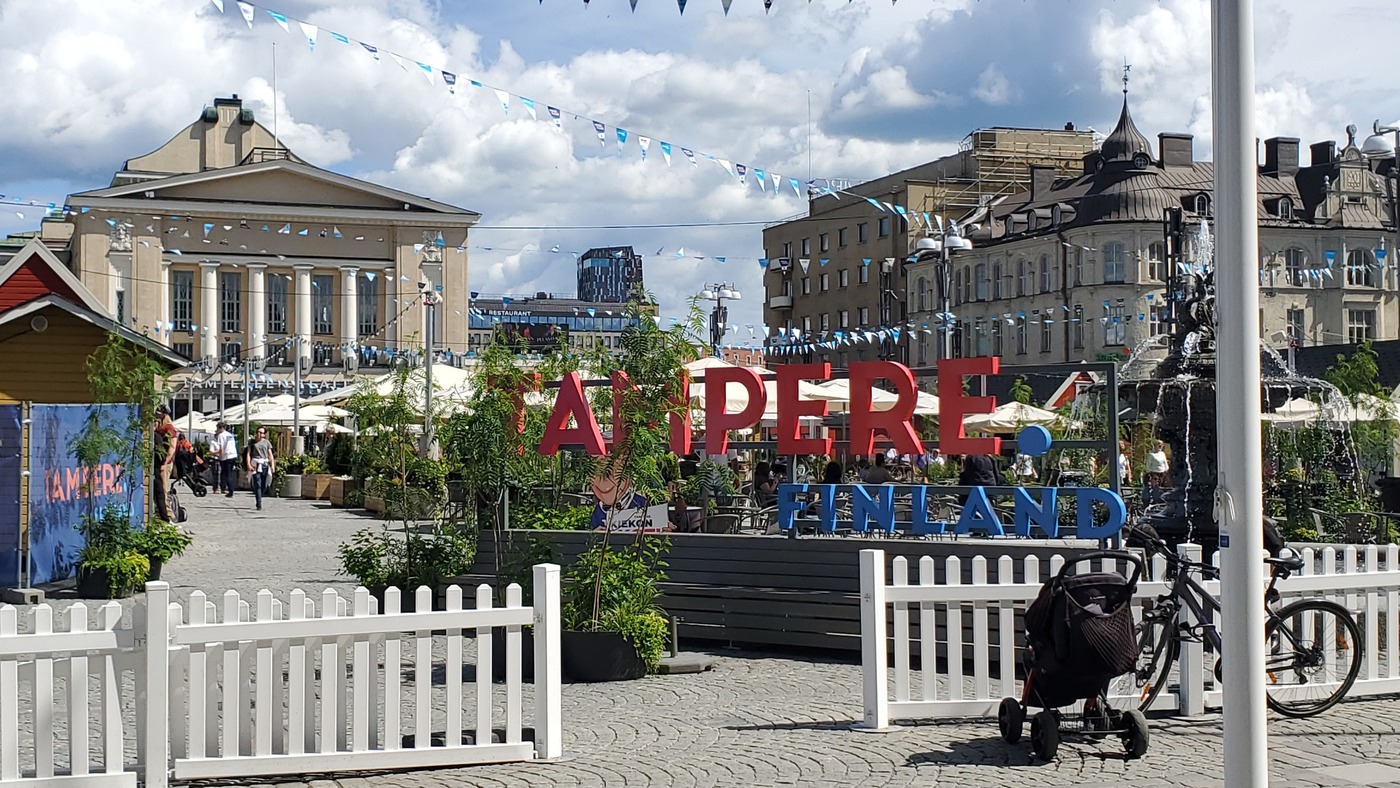
Tampere is Finland’s second city. I can already hear the complaints from the five people familiar with Finnish demography: “But wait, what about Espoo?”. First off, Espoo is right next to Helsinki and within even the most generous definitions of “metropolitan area”. Second, the jury is still out on whether or not Espoo even counts as a city as it has no proper city center, just five scattered, distinct denser urban areas that are sort of like mini-centers. Right in the middle of the whole shebang, between all the “city centers”, is a massive “park” that seems suspiciously similar to a forest. I swear I am not making all of this up, I mentioned to some Finnish people that I didn’t think Espoo was a real city and they all agreed with me (full disclosure, everyone involved was pretty drunk). The whole situation reeks of some sort of sketchy administrative meddling, and I think a bunch of bureaucrats back in the seventies may have just made Espoo up for tax breaks or other nefarious reasons. I mean, even for Finland the name “Espoo” is a bit ridiculous. Also, why are nearly all of the largest Finnish corporations headquartered in Espoo? So many questions...
In any case, this piece is supposed to be about Tampere, not Espoo. Tampere is about an hour and a half north of Helsinki by train, which doesn’t even seem to be all that far away if you look at a map and see how much further north Finland stretches beyond Tampere. It’s still solidly in southern Finland, the most populated portion, and some particularly zealous geographers might even be tempted to call it part of the Helsinki metropolitan area. Tampere happens to be the most populous inland city in the Nordic countries (note that Finland is not part of Scandinavia, which is properly only Denmark, Sweden, and Norway. I know this because I have been insistently corrected by Finns on this account several times. Apparently there is the term Fenno-Scandinavia which does include Finland, but I’ve never heard it used), a fact which you can quickly verify by opening up Google Maps and seeing that out of all the city names in the Nordic countries displayed using the largest font size, Tampere is the only one not on a coast. No, instead it’s situated on an isthmus between two huge lakes. There must be some fundamental Nordic urge to be near water.

Stepping out of Tampere’s central railway station, a drab brick building with an aggressively Functionalist white clock tower attached and a single large square window made of smaller squares, you end up on Main St. Tampere.
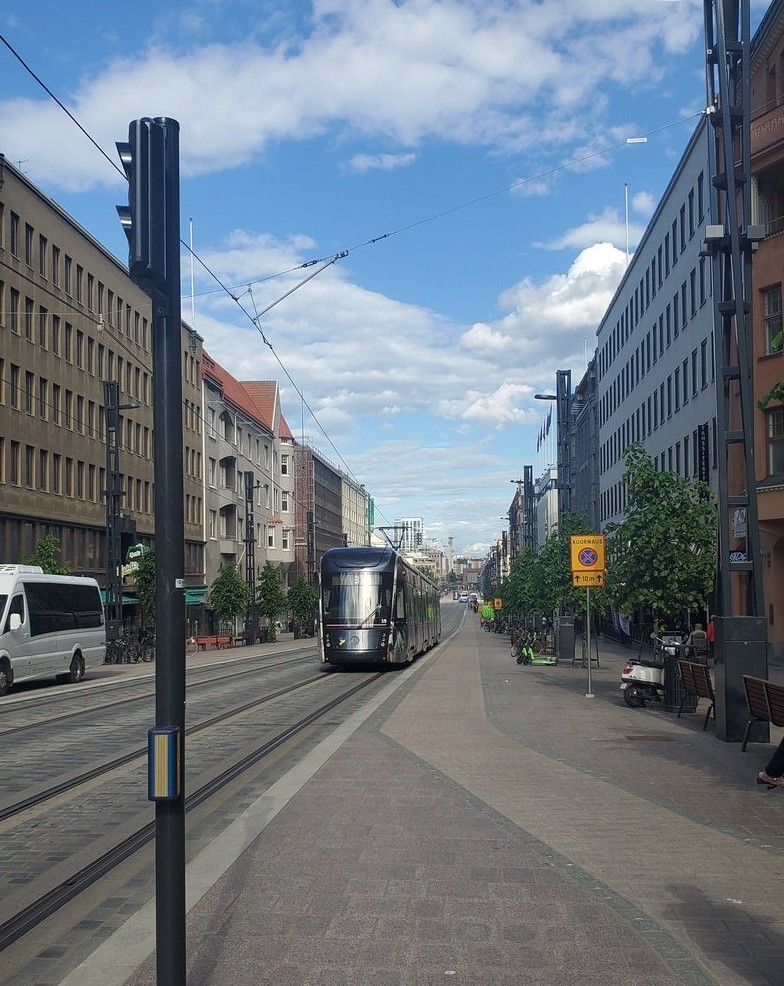
The street isn’t called that in Finnish as far as I can tell, but it should be. It’s a nice, wide street leading to the city center with shops dutifully representing every one of Finland’s retail/restaurant chains, some of which I did not even know were chains until I saw locations outside of Helsinki on this street. It’s basically a wide pedestrian street, with only the occasional tram or bus allowed to run down the center.
Down the street, you eventually end up on a bridge across what seems to be a river. Actually, it’s just a channel between Tampere’s northern and southern lakes. Why is it a channel and not a river like the Niagara River, which flows between two lakes (Ontario to Erie) as well? I guess it’s probably because it’s way shorter, only about 2 kilometers in length. However, the water flows down the channel at a decent rate, enough to get some rapids going, as the north lake is a bit higher than the southern lake. Early industrialists looking to kick off the Finndustrial revolution were quick to take advantage of the channel, and today much of the upper portion is still lined with dams and huge brick buildings. Now all of that sort of distasteful physical labor has been moved to poorer countries, so like many industrial buildings, they were gradually emptied out until hipsters realized you could put cafes, studios, and venues in them, and cheapskate businessmen realized you could also use them for tons of offices and shops.

The largest complex, practically a fortress complete with a courtyard and crenellated tower, belongs to Finlayson. The name sounds like it might have something to do with Finland, but turns out it was the last name of the company founder, a Scottish guy. Maybe it was fate, though... From the stores I’ve seen around, Finlayson still seems to be around selling tablecloths, bedsheets, and that sort of thing, but they certainly aren’t making any of them in Tampere anymore. Instead, they probably make money there now by renting out the old buildings to hip tech companies and the German discount supermarket chain Lidl. There also seems to be a modern art museum, and the interior courtyard was host to some sort of performance with hordes of parents and their uninterested kids in the audience. Leaving the fortifications, it seemed like the whole area was something of a company town for Finlayson, or perhaps more accurately a company district. On Google Maps, the whole area is labelled simply “FINLAYSON”, in the small all-caps style that identifies neighborhoods or districts. The brick behemoths give away to quaint little historic residential buildings made of wood and painted colorfully in the classic Finnish style. There is even a little Finlayson church, in brick of course.

Continuing north, I walked up a hill in a park by the lake to try and catch sight of my destination. There it was, poking up out of Tampere’s lakeside amusement park: Näsinneula, the tallest observation tower in the Nordic countries, a natural choice considering my previous work. Despite its considerable height, it was difficult to see over the hills and dense buildings in the city center, but now I could be guided towards it by sight alone. At the park ticket booth, I inquired if it was possible to buy a ticket for just the tower, and I was pleased to find out that a ticket for the tower was just eight euro (though I was willing to pay much more). The tower was outside the ticket gates for the amusement park itself, and after showing my ticket to a guy behind a slick reception desk, I was given the OK to press the elevator call button. The elevator interior was also a very polished, modern affair designed by massive multinational Finnish elevator/escalator conglomerate Kone (which literally means “machine” in Finnish) but unfortunately almost completely unphotographable with my lousy equipment due to all of its mirrors and flashing lights (enough to warrant an epilepsy warning, apparently. I wonder if epileptics can request a spectacle-free ride, or if they are just instructed to close their eyes for the duration).
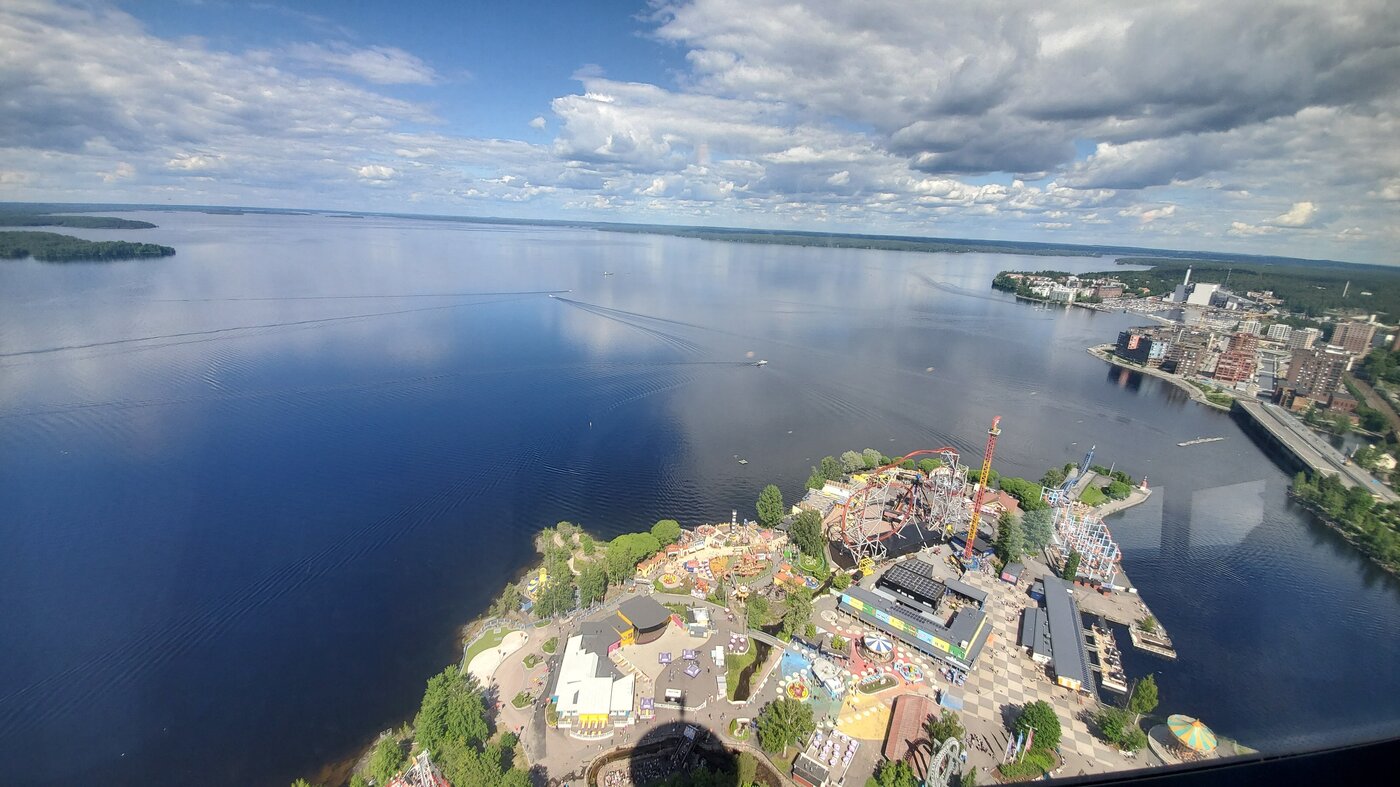
Finland is very flat and there aren’t many tall buildings in Tampere (or even Helsinki, for that matter), so the tower offered a commanding view of the surrounding area. To the north was the lake bordered by low forests in the distance, very placid on the day I came, gently opened up in a few places by tiny boats like zippers.
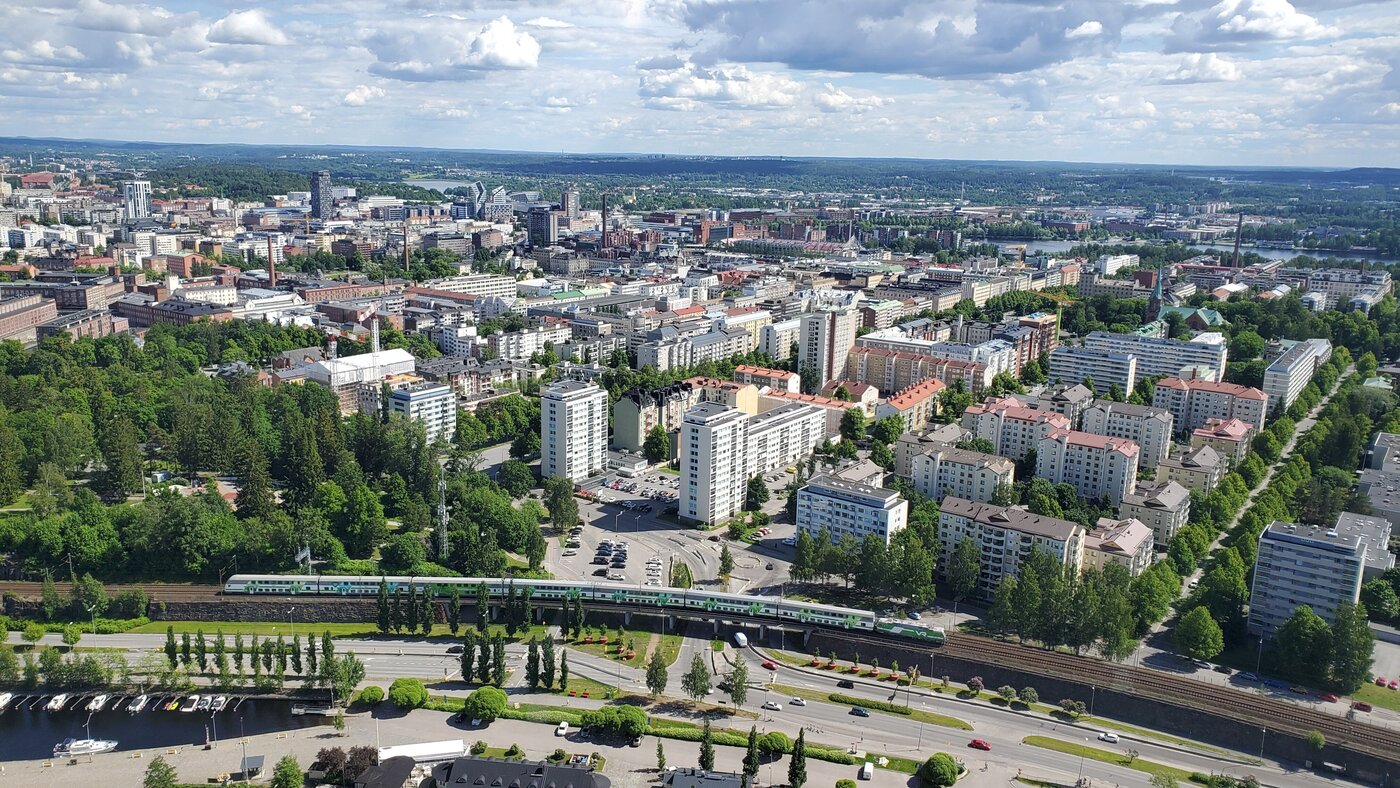
To the south, the forest gradually gives way to the big apartment blocks typical of Finland, the building density radiating out from the solid grid of the city center. In the background, some tall, angular new developments stood out by the railroad tracks. The channel was mostly hidden behind Fort Finlayson and the other buildings around it, but the southern lake it emptied into was slightly visible as a reflective sliver.

Even though the tower's exterior seemed somewhat dated, inside the observation deck I was able to find this nook with chic Nordic-style minimalist furniture, the perfect place to rest up a bit by reading my book and consuming the now-lukewarm supermarket ice coffee I had smuggled in. Upon sitting down and examining my bag I realized almost immediately that I had accidentally left my book on the train. It was probably off somewhere near Jyväskylä by now. I looked up "Lost and Found" on the VR (Finnish railways) website only to find that all they had was a phone number you could call for 2 euro a minute. So much for that. I finished the coffee and took the elevator back down to the base. Naturally, the exit was through a gift shop, which I noted had virtually no tower-related merchandise.
I headed down the lakeshore, where not a whole lot was going on since it was mostly taken up by a big road, blocked off to cars because construction was lazily proceeding on the bridge over the channel. The two construction guys working on the bridge seemed more like they were just guarding it. On the other side of the bridge was a new development, in that kind of eerie late stage of construction where the buildings are pretty much done, but the whole area is a ghost town because the construction crews have all left and nobody has moved in to replace them yet. I followed the bank of the channel down to try and find some of the more historic parts of the city.

Always guided by towers, I set my sights for a stony belltower in the distance. Sure enough, before long I was in what appeared to be Tampere's historic district, approximately 3 low wooden buildings painted in bright colors. Just past them was the cathedral attached to the belltower I had been chasing.

I wouldn't fault anyone for thinking it was an extremely historic building, as the stony facade and towers topped with pointy, bright red roofs bring to mine the archetypal medieval castle. In fact, it's only just over a century old, built in a Nordic style of Art Nouveau called "National Romantic". I've actually seen a lot of other buildings in this exact style around Helsinki which I'd always thought were quite historic as well, but no, turns out they are all from the exact same era as the Tampere Cathedral. I won't deny, though, that it looks quite nice, especially on a bright summer day.
There was no admission fee, so I popped in to the cathedral. The interior was relatively austere, typical of Protestant churches (Lutheranism is the dominant religion in Finland). This may be disappointing to some sightseers, but I find it just draws more attention to the décor that is present.
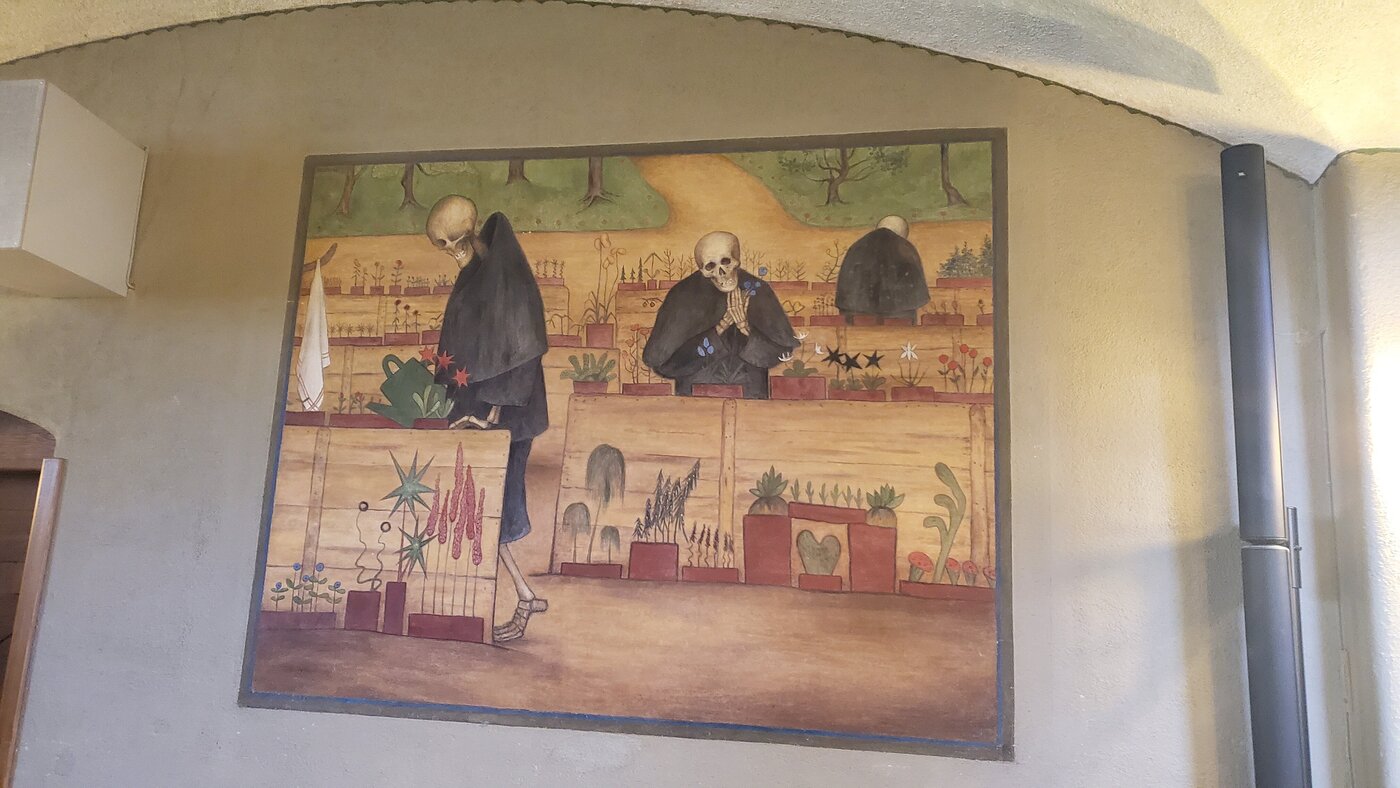
Most notable to me was a fresco to the left of the altar, of hooded skeletons doing their ominous work of... gardening. On the opposite side was a fresco by the same artist, a famous Finnish painting of two young boys carrying a wounded angel on a stretcher. Neither are really the sort of art you'd see in any historic church. I left the cathedral right as some organ practice began, not wanting to give the organist any unnecessary pressure. Plus, as a freeloader, I felt a little guilty also being treated to an impromptu concert.
Behind the cathedral, I crossed a bridge over the railroad tracks, and ended up in a large development that was pretty clearly from what I call the Finnish Soviet era. Finland was never communist or officially part of the Eastern Bloc, but you'd never be able to tell from the apartment blocks they were putting up back then. There is a joke among Finns that the Finnish city of Kouvola looks like Chernobyl, and while other cities in Finland don't get quite that bad, pretty much all of them have a district or two from that era that look like they were lifted from the Soviet Union.

The centerpiece of the area was a rather dismal asphalt city square. It was filled with market stalls, but pretty much all of them were abandoned. Maybe it was just a bad time of day. The main road leading past the square (really more of a rectangle) was unremarkable except for one curiosity: two K-Market grocery stores right across the street from each other. This is the kind of thing that only I notice because it really fascinates me for some reason, like in Japan where the 7-11 convenience store density is think enough in some places that while exiting one, you can spot another one a bit further down the street, maybe on the other side. I thought I might've been mistaken and that one of them wasn't in business anymore, but looking on Google Maps, sure enough there's K-Market Mestari and then K-Market Vellamonkatu right across the street. I will always regret not taking a picture of them while I was there.

I then walked towards the railway station (recall that it had that functionalist tower) until I stumbled upon an older mall/shopping center. I guess the technical term might be "arcade" because it was one long indoor walkway topped with an arched glass roof. It wasn't very active inside, it seemed like they had just finished a big renovation and tenants hadn't moved back in yet.

At the opposite end of the shopping arcade were a bunch of tall colorful pillars that from a distance seemed to me like one of those delightful huge abstract sculptures they love to put in public places these days, but in fact they were just a bunch of creative, though for the most part probably not very challenging, climbing walls.

After exiting the arcade and passing through a dormant university campus (summer break), I soon ended up in front of one of those big public buildings that practically demands attention with its large size and eclectic design. The building was Tampere Talo (hall), billed as the "largest congress center in the Nordics", although now I'm really starting to feel like everything is "the largest x in the Nordics".
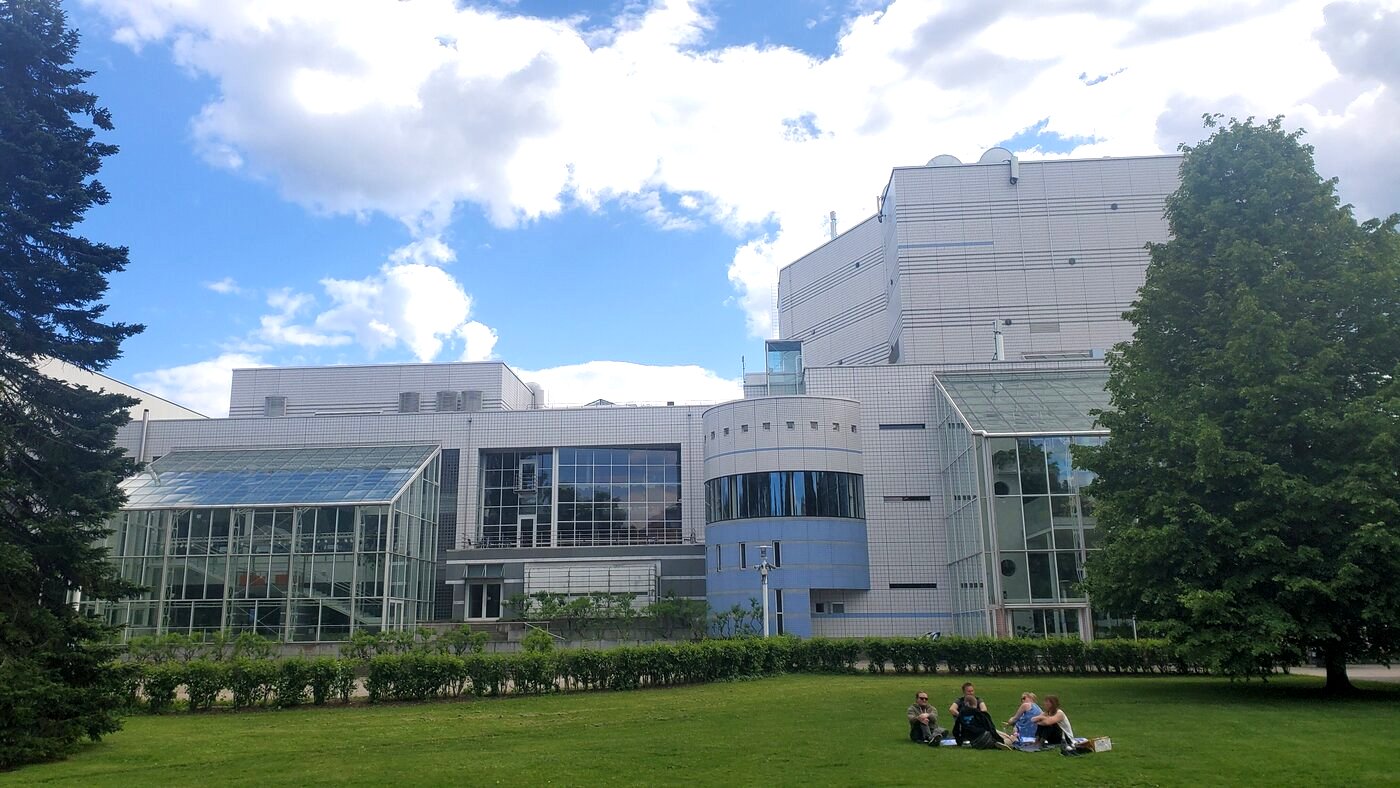
I'm not even sure what to call its architecture style but it's a distinctly Finnish one that I've already seen in dozens of public buildings around the country, so I feel like it has to have a name because surely I'm not the first one to notice this. Maybe it's just that they were all designed by the same guy. The style is defined by facades made of square windows and tiles (nearly all white) of various sizes. Overall, the building feels very geometric. like it was designed using a full set of those children's building blocks, with random cylindrical or triangular sections tacked on here and there to use up those pieces. It reminds me of some buildings I've seen in Japan, thought it could just be because slapping tiles on buildings is also popular there. I checked Finnish Wikipedia to see if they assigned an architectural style to Tampere Talo, only to find the anticlimactic cop-out "postmodernism", written in English no less.
The sign outside advertised that it was also now home to the "world's only Moomin museum", Moomin being perhaps Finland's most popular cultural export. Well, there's also Angry Birds, did you know that's Finnish? At any rate, the Moomin museum might have been closed that day because there wasn't a whole lot of activity at Tampere Hall. Everyone seemed to be in the big park beside it, enjoying the good weather as Finns do when it finally arrives.
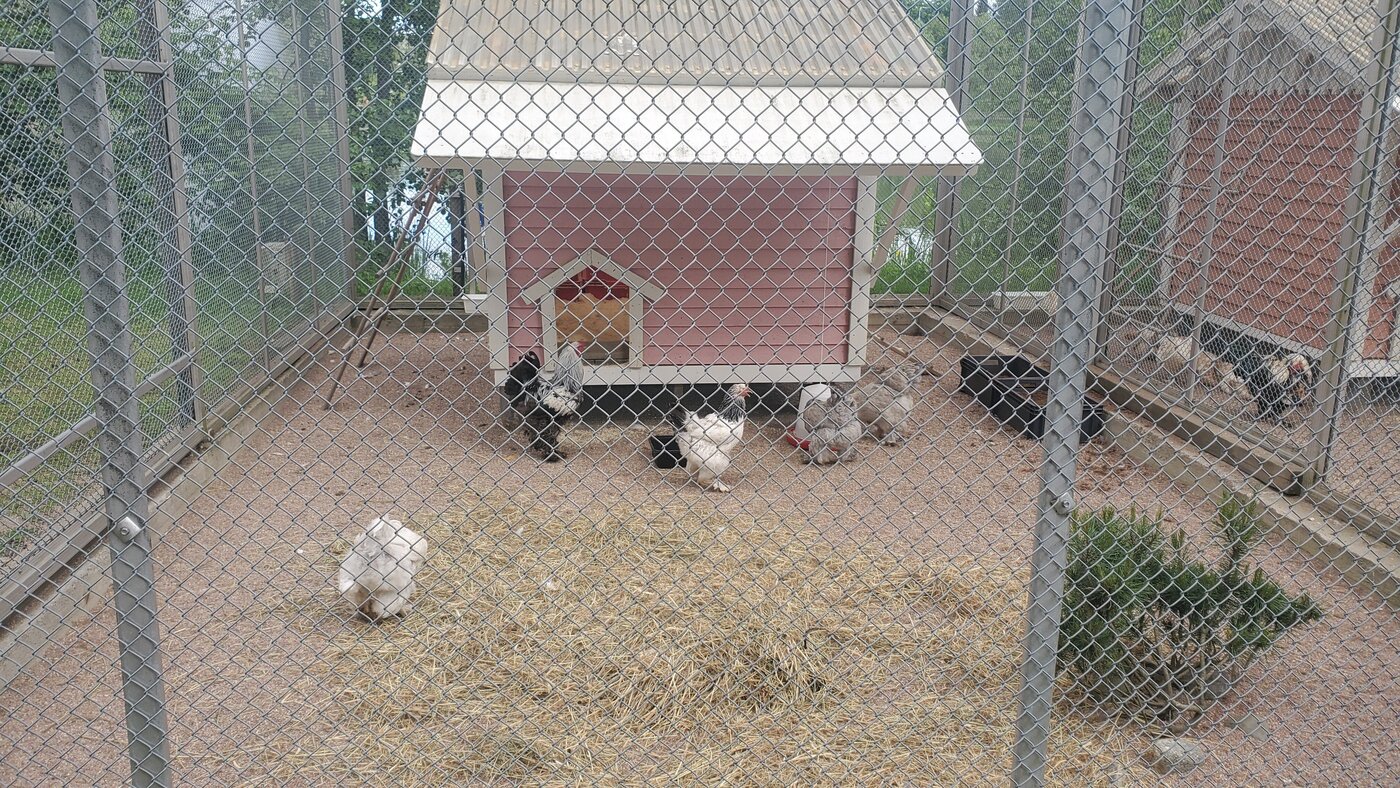
I did see something unusual in the park, a row of large cages, so I went to investigate. This was another summer tradition in Tampere apparently, cages exhibiting various exotic fowl strutting their stuff. No word on what happens at the end of summer, although there was another Finnish park fixture nearby, a grill kiosk.

Having had enough of nature, I reoriented yet again and chased a tall, modern-looking skyscraper back in the direction of the train tracks. Reclaimed from what I can only assume used to be an industrial area capitalizing on closeness to the rails, this was another area of recent development in the city. It was mostly geared towards tourism and events, exploiting the dominant form of cargo now brought in on the train: sightseers. The modest skyscraper stuck out (literally) because there was still a lot of flat, undeveloped land around, not to mention some old brick railroad buildings still sticking around near its base. It was a hotel, unfortunately not the tallest hotel in the Nordics, only the tallest in Finland. I was a bit skeptical of this claim at first as I had seen an almost identical-looking hotel in Helsinki that looked about the same height, if not taller, but turns out that one is a full ten meters shorter. Tampere's claim to yet another regional superlative is safe.

Down the street and actually built on top of the railway tracks was the real piece de resistance of recent development in Tampere: Nokia Arena. I've met a few people who might be confused by this sponsorship because they believe Nokia is some sort of vaguely Asian company, like Japanese or Korean maybe, but in fact Nokia (Oyj) is Finnish, by some metrics the largest Finnish company. Nokia got its start making toilet paper (among other paper-related products, to be fair) in Tampere before expanding to a nearby suburb named Nokia, that had a river to rival Tampere's famous frothing channel, ripe for industrial exploitation. In Nokia you can still find the headquarters and main manufacturing facility of another of Finland's largest companies, Nokian Tires, split off from the OG Nokia in 1988 so they could focus on tires over telecom.
Although Nokia is now headquartered in the questionable untown of Espoo, they haven't forgotten their roots with this arena sponsorship. I walked around most of the building, but it was really difficult to get a photo that made it look like an arena and not a shiny new shopping mall. An interesting contrast was that just across the street from the arena was a cute little brick Orthodox church. I feel like it was definitely on the smaller side (compared to Tampere Cathedral, for example), however at the same time it could have just been because it was right next to the sprawling Nokia Arena complex, into which I noticed they had even worked in a casino. The church was also boxed in from the west as well by two of Tampere's actual shopping malls, one slick new one to the left, and an older one to the right that was topped by some interesting glass domes.

I walked down the road splitting the old mall from the new and suddenly found myself facing the Tampere Harbor. From this angle, it looked just like a small, less fancy version of Helsinki's harbor, a market square surrounded by buildings and a few boats docked in the water. You'd never guess that it was actually just a wide part of a channel at the mouth of a lake, instead of the sea or even the oceran. I crossed a pedestrian bridge over into the harbor square and noticed another difference from the Helsinki Harbor: there was a massive industrial building trying to make use of some of that prime space right next to the channel.
The harbor square was just at the edge of the city center, so I headed back in until I stumbled out into yet another square, Tampere's central market square. It was surrounded by important-looking historic buildings, but it was difficult to get a good picture of any of them because the square was absolutely filled with the static cousins of food carts (stalls, I guess) along with a cozy seating area for them. Incidentally, this is where I took the photo of the Tampere sign that's at the top of this page, which was also difficult to get a picture as it was partially obscured by potted plants, even though I'm pretty sure the whole point of the sign is to be photographed.
I then strolled through the adjacent park, boasting a church and another historic building being used as a museum. It had quite a strange vibe for a park smack-dab in the middle of the city. Gangs of what I can only describe as hoodlums or miscreants drinking beers and smoking, sitting on ledges or on a stage in front of rows of empty audience seating. There was a heavy stench of weed in the air, which is not (yet?) legal in Finland. Several skateboard ramps were scattered around, including one jarringly placed right in front of the historic-looking building.
At this point I had been walking around pretty much nonstop for several hours, so it was time to get something to eat. My goal was to go to a Tampere "original": Siipiweikot, credited with bringing hip modern hot wing cuisine to Finland and now with locations across the country. To this day, though, Tampere is still top in Finland when it comes to chicken wing consumption. I figured that since Siipiweikot has a couple locations in Tampere, they are guaranteed to have at least one somewhere in the city center, I just had to walk around until I found it. After twenty minutes of unsuccessful aimless wandering, I stopped at the railway station and looked up the location because my legs were about ready to give in. There it was, hidden just around the corner of one of the streets I had just been down. I sheepishly returned the way I had come.
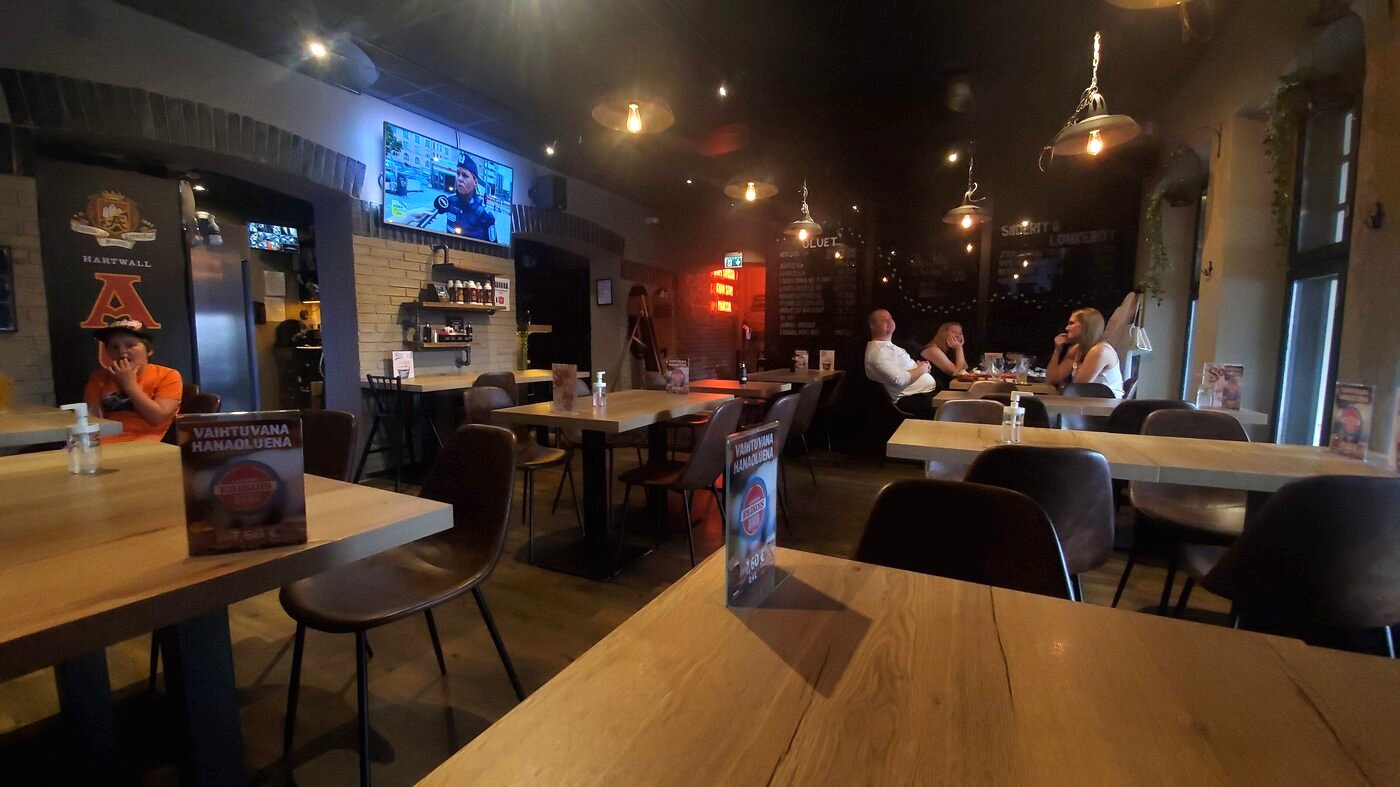
The exterior of the restaurant, not to mention its location, was a bit unassuming for what I had been led to believe was a city institution. The inside was cozy and it wasn't very busy around 6 pm, but I guess wings are sort of a late-night thing. My spice tolerance is only somewhat above average which makes it easy to overshoot, so ordering at a new wing joint is always risky. There was also the fact that I was in a completely different country as well. I ended up going with the "safe" option, 4 out of 6 flame marks. I noted that the hottest option was called "Kamikaze", the same as the hottest option at a place back home. Cliché name or international convention, I wondered.
I'm not in the habit of taking food pictures so a verbal description alone of the meal is going to have to suffice. It turned out I had a bit too much faith in Finnish spice levels as my wings ended up being not bad at all, close to not being spicy enough. The waffle fries on the side, along with "BBQ Mayo" dipping sauce were quite good though (Finns are obsessed with mayo, the sauce options were just 6 types of mayo. Finland's largest fast food chain, Hesburger, basically just serves Whataburger-sized McDonald's burgers drowned in mayo, and also has several types of mayo for sauce options). I had been previously warned that it is on the expensive side, however I managed to escape with a decent meal of ten wings and waffle fries on the side for only 14 euro. I think the pain point for people might be the overpriced beer, which I steered clear of.
In a daze, I staggered from Siipiweikot down the main street directly back to the train station. According to the ticket machine, a commuter train was leaving for Helsinki in ten minutes. Yes, apparently Tampere is close enough to Helsinki that they run commuter trains every hour or so. I guess Tampere really might be in the Helsinki metropolitan area...
The trip would take a little longer as commuter trains stop at every station, but I didn't mind. More time for a nap. I found an empty seating area of six seats together towards the front of the train, and got comfortable. Before long, the train pulled out of Tampere. I checked the time on my phone. I had only been in Tampere about 5 hours. It had felt like an entire day at least.

